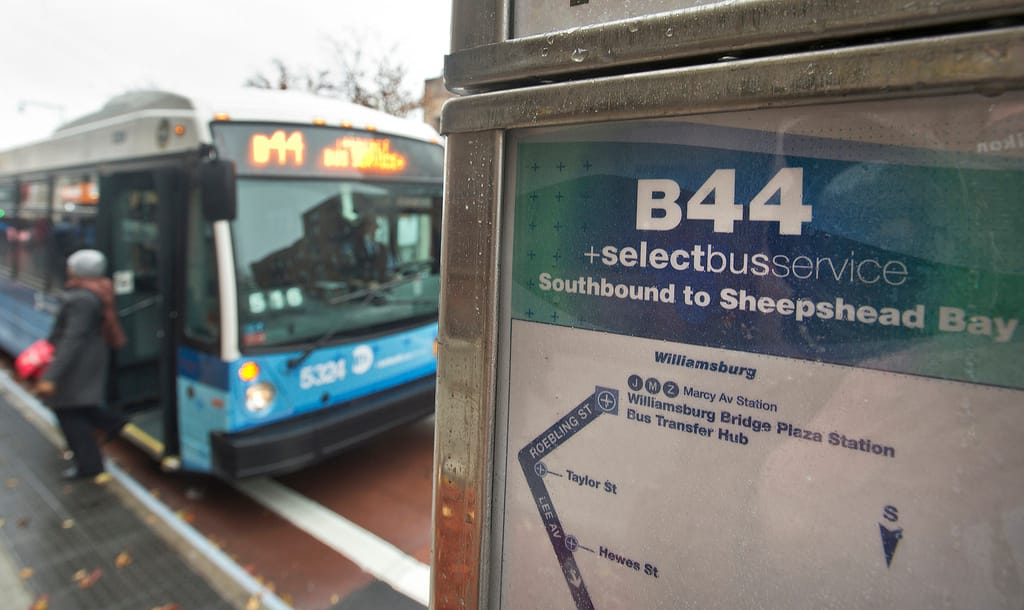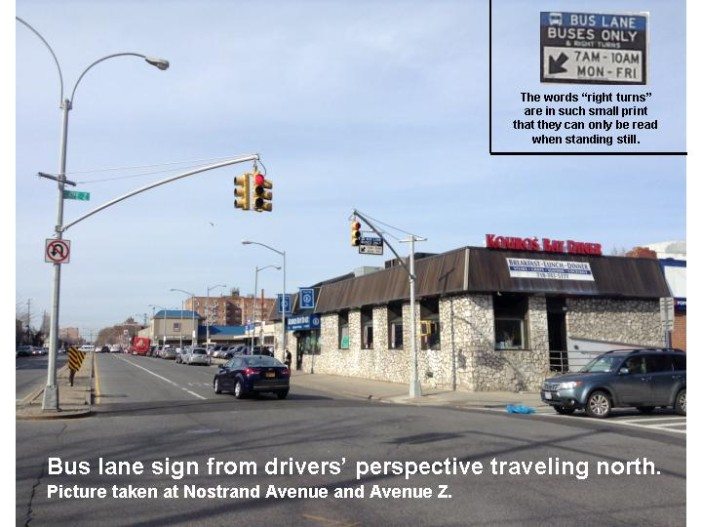The Commute: Why We Need A Moratorium On Future SBS Routes – Part 5 Of 5


THE COMMUTE: In Part 4, we discussed installing true Bus Rapid Transit (BRT) for the Woodhaven Boulevard Corridor. Now we will look at general problems with Select Bus Service (SBS), which the MTA and DOT ignore in their “infomercials” misnamed community involvement.
The Problem With Transfers
You are allowed to transfer between a local and express train without penalty, and even between express and local buses. So why, if you want to take the local bus to bring you closer to an SBS bus without an unlimited pass, you are deprived of your free transfer to another bus or train? Some drivers accept your SBS receipt, as if it were a transfer, when entering a second bus so you can use your MetroCard again on another bus or train without being charged. They are aware of the unfairness of the system. However, no MTA documentation states that this is official MTA policy and this tactic may only work if you board the SBS first.
The Problems With Enforcement
This is another major issue. Probably the huge majority of those receiving summonses deserve it either for fair beating or for driving in a bus lane. However, a substantial number of innocent people are trapped in a system wherein they are automatically found guilty in an enforcement mechanism called the Transit Adjudication Bureau (TAB). This is designed to frustrate the commuter by requiring them to waste an inordinate amount of time. Hearings are often postponed and require a person to lose at least a half-day’s pay so the incentive is to pay even if innocent. If the commuter does not publicize their case by going to an elected official or the media, they will most likely be found guilty no matter what the circumstances may be, such as the driver telling them that it was okay to board and pay at the next stop.
There have been cases in which drivers have been ticketed for driving in the bus lane during times when it is permitted, or given a citation literally 10 seconds before cameras were due to shut off. Lane markings frequently are worn out and small overhead signs placed at the corners cannot be seen after just making a turn. Those signs may be your only warning that you are driving in a bus lane on the lower portion of Nostrand Avenue where pavement markings have worn out in less than a year. (See lead picture) It is very easy for someone who has never heard of SBS to unknowingly find himself in a bus lane after making a turn and receive a fine varying between $115 and $150.
Many times, as any motorist knows, the only way to find a parking space is to see someone pulling out. However, if there is a bus lane in effect, even if no bus is being delayed, you are still subject to huge fine merely by stopping for 10 seconds while waiting to park. Our elected officials are being bombarded with such complaints. Is this fair?
Sometimes a bus passenger doesn’t notice the fare kiosks if they are placed at the rear of the bus stop and someone is approaching from the front, or both machines may be inoperable or out of a paper receipt. There have also been instances in which a machine has removed all your money from your MetroCard. Are you supposed wait for a local when that happens even if you do not have a spare card? (There is no local B44 in Williamsburg — only an SBS.) What about during a snow or ice storm? Muni-meters are sometimes isolated in mounds of snow or are completely glazed over in a sheet of ice. Couldn’t that also occasionally happen to SBS fare machines? These problems can be corrected, which I shall discuss later. Well-meaning citizens should not have to suffer financially.
The Problems With Exclusive Bus Lanes And Articulated Buses
While exclusive bus lanes can be a great tool to speed up bus trips and improve bus reliability, it does not mean that every street with a bus route needs an exclusive lane, full or part-time. A careful analysis must first be done using existing traffic data and projections using a computer model. Bus frequencies must also warrant an exclusive lane.
These lanes as well as articulated (long) buses also necessitate the removal of scarce parking spaces because the longer bus stops require more room. The DOT should survey the surrounding areas to determine if any of these eliminated parking spaces can be replaced with new legal spots within the vicinity. This could be accomplished by restoring parking where it has been banned unnecessarily, for example, because the original need for the parking ban no longer exists. This would minimize the impact to motorists and commercial establishments that suffer from reduced parking availability. The needs of bus riders are no more important than the needs of everyone else.
What Should Be Done
State legislators recently requested that, during a blizzard or ice storm, meter regulations be suspended, since the areas around muni-meters are not cleared. It may be impossible to climb over mounds of snow or use a meter covered with a sheet of ice. Isn’t the same true with SBS fare machines?
Payment should be allowed on the bus using a MetroCard when this happens. There could be a temporary cover over the MetroCard slot, which could be removed when there is a problem with the machines. Passengers could be given paper receipts from the driver to indicate that the fare has been paid, or else inspectors could be equipped with scanners to check the MetroCard to determine whether a fare was paid. Problems at TAB must be corrected.
The entire truth about SBS needs to be told — not only its positive aspects. Misleading and incorrect information should not be disseminated. A coalition similar to the one in favor of SBS needs to be formed to prevent the fatal mistake of BRT on Woodhaven Boulevard. This will not be easy since political deals have already been cut.
Even those opposed to SBS on Woodhaven Boulevard are reluctant to step up to the plate. Recently, I had a private conversation with one of the elected officials in Queens who is convinced that SBS along Woodhaven will be a disaster, but will not take a public stand because he or she believes that it is a done deal and any effort to try to stop SBS will be a waste of time.
The MTA transfer policy must be made clear and no one should be penalized for taking a local service to access an SBS bus if that is what they want to do, since SBS stops are spaced as far as a mile apart.
Implementation of the B46 SBS should be delayed until the results of the B44 SBS are released and the public has had an opportunity to review it. We do not need a second Brooklyn SBS route if the first one has not been proven successful and has exhibited problems that have not been resolved.
Lane Markings and signage need to be improved.


The Need For Transparency
- The DOT and the MTA should not be allowed to make wild allegations regarding SBS and BRT without providing adequate proof.
- We must see the data from NYCT Transit’s forecasting model and DOT’s traffic model as well as the assumptions made to produce that data.
- Traffic counts and projections must be provided to substantiate that traffic will not be significantly adversely affected before general traffic lanes are removed and more left turns banned from Woodhaven Boulevard.
- Requests from the public for data need to be provided.
- There has to be additional follow-up after the initial first year reports.
- We need to know the cost for enforcement and if this cost is more or less than the revenue it produces from fines, and proof that fare evasion has been reduced due to SBS.
- We need to know the true costs of SBS and BRT so that an intelligent decision can be made whether the benefits outweigh the costs. Federal money must not be regarded as free money.
- It should be easier to learn about proposed SBS routes and meetings need to be better publicized. The MTA website is too cumbersome. DOT’s site is better if you think to look there.
- DOT asks you to e-mail them to learn how to join a Community Advisory Committee (CAC). In reality, you cannot join a CAC because they are not open to the public, only to elected officials, Community Boards, neighborhood groups, civic organizations and major institutions; only one member from each group is chosen.
- It must be proven that more are helped than hurt by SBS by considering everyone’s needs.
Until all this is done, there should be a moratorium on new SBS and BRT routes. The SBS can be beneficial and is a powerful tool to speed up trips for bus riders. However, at this point, there are too many unanswered questions to blindly move forward and implement 13 new routes in fewer than two years.
The Commute is a weekly feature highlighting news and information about the city’s mass transit system and transportation infrastructure. It is written by Allan Rosen, a Manhattan Beach resident and former Director of MTA/NYC Transit Bus Planning (1981).
Disclaimer: The above is an opinion column and may not represent the thoughts or position of Sheepshead Bites. Based upon their expertise in their respective fields, our columnists are responsible for fact-checking their own work, and their submissions are edited only for length, grammar and clarity. If you would like to submit an opinion piece or become a regularly featured contributor, please e-mail nberke [at] sheepsheadbites [dot] com.



